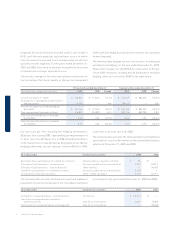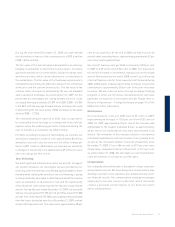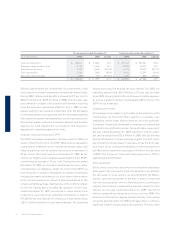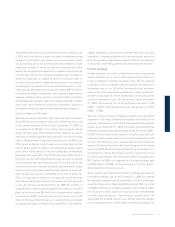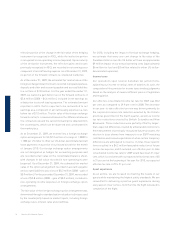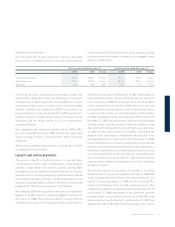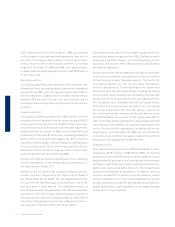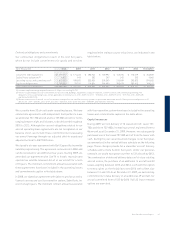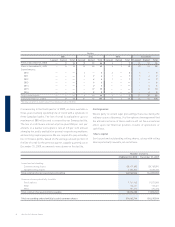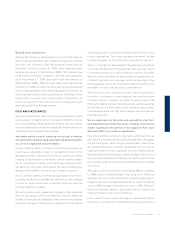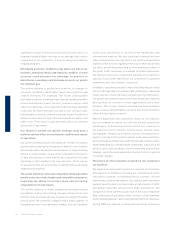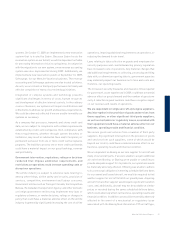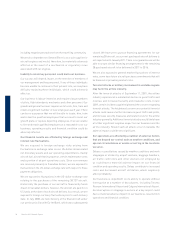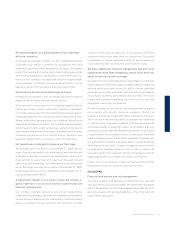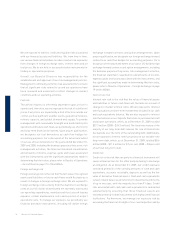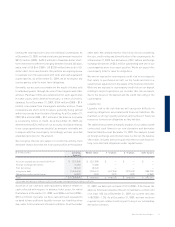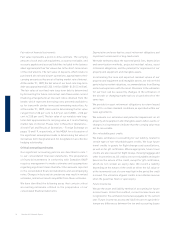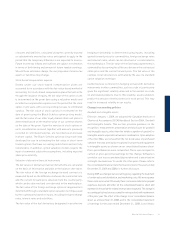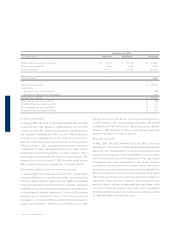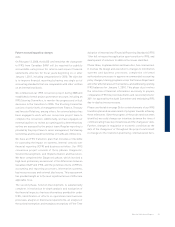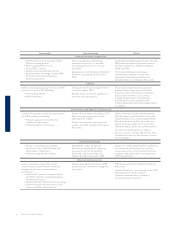Westjet 2009 Annual Report Download - page 56
Download and view the complete annual report
Please find page 56 of the 2009 Westjet annual report below. You can navigate through the pages in the report by either clicking on the pages listed below, or by using the keyword search tool below to find specific information within the annual report.
26 WestJet 2009 Annual Report
airline plus numerous U.S. carriers in the transborder and
international markets. We face signifi cant competition from
other airlines that are serving most of our existing and potential
markets. Other airlines regularly meet or price their fares below
our fares, potentially preventing us from attaining a share of
the guest traffi c necessary to maintain profi table operations.
Our ability to meet price competition depends on our ability to
operate at costs lower than that of our competitors or potential
competitors over the medium to long term.
In addition, consumers are able to more effectively shop for travel
services through Internet websites and, particularly, wholesale
travel sellers to more effectively compare pricing information.
The growth and competitiveness of Internet distribution channels
have pushed air carriers to more aggressively price their
products. This, in turn, reduces yield and may have an impact
on our revenue and profi tability, as more and more consumers
utilize this distribution network.
With the aggressive and competitive nature of our industry,
we turn inwards to realize cost effi ciencies and competitive
advantages. Conventional airline profits are sensitive to
the general level of economic activity, taxes, interest rates,
demographic changes, price levels, special circumstances or
events occurring in the locations served, and to external factors
such as foreign exchange rates and international political events.
Notwithstanding our variable profi t share plan, a portion of an
airline’s costs, such as labour, aircraft ownership and facilities
charges, cannot be easily adjusted in the short term to respond
to market changes.
The failure of critical systems on which we rely could harm
our business.
We depend on automated systems to operate our business
and support our initiatives, including our computerized airline
reservation systems, telecommunication systems, aircraft
maintenance system and website. Our website and reservation
systems must be able to accommodate a high volume of traffi c
and deliver important and accurate flight information. Any
disruption in these systems could result in the loss of important
data, reallocation of personnel, failure to meet critical deadlines
and increased expenses, and could generally harm our business.
During 2009, we replaced or enhanced several key technology
signifi cant increase in the price of aircraft fuel could result in a
disproportionately higher increase in our average total costs in
comparison to our competitors, if they are using more effective
hedging programs.
Worldwide economic conditions may adversely affect our
business, operating results and fi nancial condition. A weak
economy could decrease our bookings. A reduction in
discretionary spending could decrease amounts our guests
are willing to pay.
The airline industry is particularly sensitive to changes in
economic conditions, which affect guest travel patterns and
related revenues. For example, the recent unfavourable
worldwide economic conditions have reduced spending for both
leisure and business travel. As such, a weak economy could
reduce our bookings, and a reduction in discretionary spending
could also decrease amounts our guests are willing to pay.
Unfavourable economic conditions can also impact the ability of
airlines to raise fares to help offset increased fuel, labour and
other costs. These factors could adversely affect our revenues
and results of operations.
Our failure to achieve our growth strategy could have a
material adverse effect on our fi nancial condition and results
of operations.
Our growth strategy involves increasing the number of markets
served and increasing the frequency of fl ights to the markets
we already serve. During the initial phases of implementing
service in a new market, we are more vulnerable to the effects
of fare discounting in that market by competitors already
operating in that market or by new entrants. There can be
no assurance that we will be able to identify and successfully
establish new markets.
The airline industry is intensely competitive. Reduced market
growth rates can create heightened competitive pressures,
impacting the ability to increase fares and increasing
competition for market share.
The airline industry is highly competitive and particularly
susceptible to price discounting, because airlines incur only
nominal costs to provide services to guests occupying otherwise
unsold seats. We primarily compete with a small number of
Canadian airlines in our domestic market, and one Canadian


